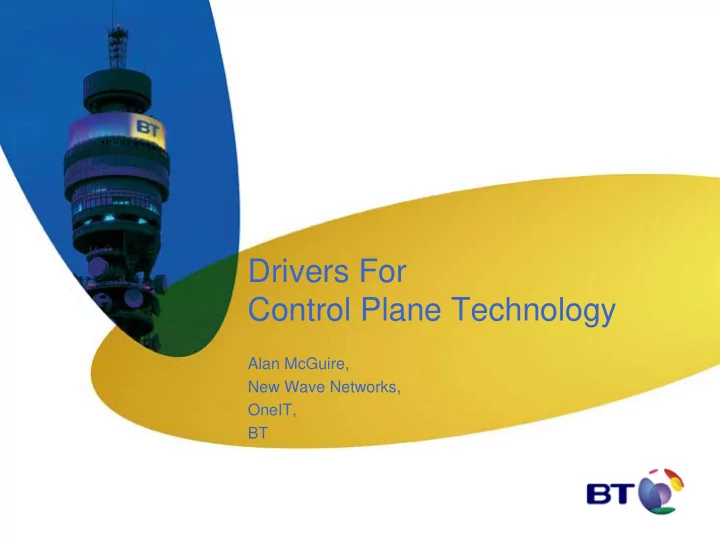

Drivers For Control Plane Technology Alan McGuire, New Wave Networks, OneIT, BT
Management & Control • Starting point is service management • Network management criticism cannot be applied universally – Not all systems are the same! • Levels of automation vary considerably – Processes, planning philosophy, network structure, play a large part • Require – distribution of functionality between control plane and management plane • Implementation choice with strong dependence on legacy – Component model of ASON • Want reuse of some capabilities in existing OSS • Delegation of authority – there can only be one captain of the ship
Business Drivers t r u st t h e fl u ffy t r u st t h e fl u ffy t r u st t h e fl u ffy t r u st t h e fl u ffy cl ou d cl ou d cl ou d cl ou d • Radically simplified network • Allow the network to manage restoration - eliminate complex protection options & routing decisions • OPEX reduction from hands-off operation using the control plane to manage restoration and planned work - radically reduce need for manual intervention (also achieved by simplifying the network) CAPEX reduction from shared restoration • • Simplified product set using control plane restoration Simplified planning process with capacity planning & management • structure • Reduction in OSS stack complexity - BUT not replacement
Operational Aspects • Integration with essential OSS allows: – management of the network as a seamless entity with agreed and working interfaces into overall network capacity management and plan and build – management of customer service end-end with alarm and performance data • Manage separation into and out of the control plane cloud but not within it. • Repair is an offline activity. Restoration of service is not dependent on repair
Hybrid Connections Fits ASON distribution model! Determine end points SM SPC Network Request NMS Model Routing SNM EM EM Control and management Legacy managed Legacy managed plane enabled network network domain 3 network domain 1 domain 2
Soft Permanent Connections • Connections setup by network operator using signalling – similar to many installed ATM networks • Managed connection characteristics – time to allow for order placement by customer, service management and network management processes – establishment of connection – testing of performance prior to handover to customer – wrap-up time • Minimises impact on OSS
Dynamic/Switched Services • Examples that have been proposed in literature – Distributed storage area networks – LAN extension – Disaster Recovery – Outside broadcast for major sporting events – Layer 1 virtual private networks – Real-time traffic engineering • How well can they be supported – Erlang models provide a good indication
Classical Performance Requirements • Traditional performance requirement for the Phone Network is simply defined by the percentage of calls blocked in a single hour – assumes Poisson arrivals and negative exp holding times, infinite sources • Adopting above for a transport network leads us no further – Phone network is scale invariant: passing to a system with longer holding times has no effect on network sizing or cost – Phone network is independent of the 1-hour assumption, this merely serves to define the duration (the busy hour) over which the reference traffic is measure • Scaling up the holding time in above way would however lead to relaxation times that would be unacceptable to the customer.
New Service Criteria • We suggest that any network which offers single high bandwidth connections should be designed and dimensioned not on the basis of the percentage of calls blocked, but rather on a delay basis. A suggested service description might be: • A request for a connection will be successful immediately on at least S% of occasions; of those not immediately successful, T% will be satisfied with a delay of not more than t.
Delay System • Enqueued, FCFS • M/M/N queue model • N: discrete circuits, A: offered traffic, H: Holding time • Classical Erlang Theory • Conditional mean delay = H/(N-A) • Conditional median delay - 0.69H/(N-A) • Conditional 90th Percentile delay = 2.3H(N-A) NE ( A ) NB = = = N P ( queueing ) C ( A ) − − − − N N A ( 1 E ( A )) N A ( 1 B ) N • − − < = + − − ( N A ) t P ( service time t ) P ( 0 ) ( 1 P ( 0 ))( 1 e ) P(0) - Probability of immediate service
Example 25.0 Delay, given immediate blocking 20.0 15.0 (hours) Cond 90% 10.0 Cond mean 5.0 Cond median 0.0 0.1 0.01 B - for loss N=16, CHT=24 hours, 0.01< B < 0.1
Example 1 Probability of service within time t 0.9 0.8 P (<24 hours) 0.7 P (<1 hour) 0.6 P(0) 0.5 0 100 200 300 400 Mean CHT (hours) N=16, B=0.1, A=13.5
Conclusions • Major driver is soft permanent connections • Strong interaction with network management required – control plane only solutions inadequate – offline tools and many OSS functions required – hybrid connections required to work with installed base • Studies suggest it may not be commercially viable to offer a switched service for long-holding times: the expected delays for initially blocked calls are likely to be intolerable to users • ASON tutorial – A. McGuire, G. Newsome, L. Ong, J. Sadler, S. Shew and E.Varma: “Architecting the Automatically Switched Transport Network: ITU-T Control Plane Recommendation Framework”, Chapter 16, Optical Network Standards, Edited by K. Kazi
Recommend
More recommend